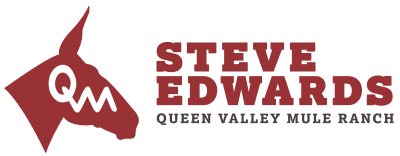Ground Foundation Training for Mules and Donkeys
I get a lot of questions from folks wanting a better relationship with their animals. I love helping people with their mules and donkeys. One thing I love about what I do is that I get to make the lives of mules and donkeys better. Mules are one of God’s best creations.
Here’s a Question I Just Received
Recently, I received a long question from Sam about controlling his mule. Here’s the shortened version.
I have a mule that is seven-years-old. When I got him two years ago, he was feral. Human hands never touched him until I bought him when he was four- years-old. Recently, when riding, a flock of young turkeys took flight all around us; the mule didn’t bat an eye! But when mama turkey appeared in the grass 10 feet away, it was too much for him. He bolted back towards the barn. The Come-A-Long hitch really worked on his nose. Does a Hackamore have the same controlling force?

It Would Take a Book
My response started with, “It would take a book to tell you what you need to do. And the Hackamore will not help.” I will not write the book here, I’ll give you the short answer.
There are a couple of issues here. The first issue is that mules have a fright and flight response built into them; there is absolutely nothing you can do to take it out of them. All equine use it to escape from what they perceive as a problem.
The second issue is foundation training. Mules and donkeys need to have at least six months of training, about four to six hours per week; it is critical to train every week. Don’t overdo your training and don’t train every day. It’s easy to want to keep working and move up the training schedule, but mules don’t work like that.
Always Start With Foundation Training
Before Sam gets back on his mule, he should complete six months of foundation training. Foundation Training is learning to communicate with your mule or donkey through your hands, through the lead rope, and then the halter. You want your communication to be crisp and clean.
It is imperative that we start with the Come-A-Long rope, which will teach your mule how to go forward and backward, to go to the left or to the right – to go where you tell him to go and stop when you tell him to stop.
Sam has my Come-A-Long rope which he used to stop his mule from pulling away. Way to go, Sam! You’ve got the best tool with which to start your foundation training.
Using the Come-A-Long rope allows me to draw a clear line between comfortable and uncomfortable for the mule or donkey. Do what I ask and there is no pressure on your precious nose. It’s that simple. Mr. Mule will always opt for comfort when given the choice.
Remember that mules and donkeys care more about their nose than they do their mouth. As we bump the rope, it communicates to the nose first, underneath the chin second, and behind the pole third. It gives the mule the opportunity to go with the easiest touch: the nose.
There are three simple commands: Ask, Tell, Demand. First, I’ll bump, which means I’m asking. Next, I will bump-bump, which is telling. Then, if the mule hasn’t yet done what I asked, I am going to rapid fire my lead rope – bump, bump, bump – which puts a lot of discomfort on the donkey’s nose, that’s demanding. The palm of my hand is always pointing down. By pointing down I can roll my wrist, which is what I mean when I say bump.
After your mule understands ask, tell, demand, the next step is teaching him to walk straight, move in circles, and make figure eights. The steps are similar for each movement.
Let’s start with walking straight. Pick a straight line, maybe from one side of the pen to the other or from the gate to the big Mesquite tree across the yard. Using the Come-A-Long rope, start walking the line, not allowing the mule to look to the right or to the left. If he looks to the left, bump his nose. If the mule pulls back a little, keep moving forward and give his nose a bump. ’Ole Fluffy doesn’t like to be uncomfortable, so he moves forward.
We do everything in 3s, 6s, 9s and 12s, that is imperative for foundation. The first day, lead the mule to the tree and back to the gate three times. You’re done for the day. The next day, do the same thing three times, two days later, three times. Train with your mule four-six hours a week. Next week, if the foundation is correct, walk from the gate to the tree six times four-five days.
The following week it’s nine times in a straight line, and the week after that it’s twelve times. Now that the mule has walked a straight line well for four weeks, you can move on to circles, clockwise and counterclockwise for four weeks.
Your ability to communicate with your mule and putting in six months of proper training will help you when you’re riding, packing, or just brushing ’Ole Fluffy.
I would suggest that you get the Problem Mule, Building a New Foundation video for even more information about foundation training.
Next Is Halter Training
A fully adjustable rope halter is your second phase of training. I don’t usually introduce the halter into my training process until the third month. It’s a refined way to teach the mule how to go left, go right, backup, and stop.
A properly adjusted rope halter has big knots in it, one on each side of the nose, two fingers up from the nostril. When you ask your mule to go left or right, stop, or backup, you put pressure on the knots on the halter with the lead rope.
Let’s start with training your mule to back up. Start by putting constant pressure on the halter with the lead rope pointing to your chest. The mule will get uncomfortable and try to figure out how to get the pressure off his nose. He will stick his nose up, move it to the left and right, but the pressure will still be there. When he drops his head, I will remove the pressure; that’s the mules first step to an understanding that when both knots are on the nose and a small amount of pressure is there, the mule needs to back up.
When he drops his head, you relax the lead rope for five seconds, then put the pressure back on the lead rope. The mule will drop his head again, thinking the pressure will stop. It doesn’t; you keep the pressure on the lead rope. The mule moves a foot backwards – immediately release the pressure on the lead rope for five seconds. After five seconds, put pressure back on the lead rope. When the mule moves two of his feet, release the pressure for five seconds.
The mule understands that as soon as he feels a slight amount of pressure on his nose with the right and left knot from the halter, he needs to go backwards. As he goes backwards, the knots release, he gets back to his comfort zone. You’re taking the mule’s thoughts of comfortable, uncomfortable, and you are teaching him that if he responds correctly to the halter, you will release him.
My Mule Ground Foundation Starting Kit will help you establish that open and meaningful line of communication that you need to have with your mule or donkey.
Training To Ride
After working through ground halter work, what’s next? I would suggest building a foundation using my Mule Rider’s Martingale which will give you the control you need to have when you run into problems such as a runaway. This bit-bridle combination keeps the animal’s nose on the vertical and keeps their head down so you can focus on communication. You can order the Mule Rider’s Martingale on my website; it comes complete with a bridle, reins, and how-to DVD.
The Mule Rider’s Martingale will give you full control and will also keep the mule from elevating his head and tightening all his neck muscles. Just the snaffle bit by itself will teach the mule to brace and after a while they’ll start raising their head and tightening their neck.
I’ve written an article called Mule Bits – Everything You Need To Know that includes a lot of information about training and bits. Check it out.
Keep Up The Foundation Training
You’ve worked with your mule or donkey for six months. You’re done! You did it! You never have to do foundation training again! Wrong! Everybody thinks once Mr. Mule is trained, he will stay trained in every situation. That just isn’t so. A new situation can create some new problems.
You will want to take a few minutes in a new place to remind your mule of his foundation training. I always bring my Come-A-Long rope and a rope halter so Mr. Mule and I can do a quick tune-up to remind him of his foundation training. If your foundation training is correct, then in just a matter of minutes the mule gets a hold of it.
With mules, it’s a simple tune-up: Do you remember? Do you remember? Do you remember? Don’t climb on a mule when he’s upset, take care of it on the ground first. Make sure everything’s right, do your tune-up. Do some of the ground foundation you did for six months. Walk your mule in a straight line several times, not letting him turn his head to the left or to the right. Have him walk a figure eight, both directions, until he does it. Double check that the tack is properly adjusted. Okay, now climb on. As your mule progresses, the more he gets to understanding things, the quicker the tune-up gets done.
I’m Here to Help
If you are having some problems with your mule, I hope this advice helps you. Just remember, it all starts by building a foundation with your mule.
As always, you can give me a call me or send me an email, including photos and videos about questions you have about mules and donkeys.
Happy Trails!
- Posted in: Articles, Everything, Halter Training
- Tagged: Articles, Everything, Halter Training



4 thoughts on “Ground Foundation Training for Mules and Donkeys”
Do you have any videos? On the ground work ?
yes Ground communicaation kit on my web site
Dave and Steve
Next Is Halter Training
I am wondering if in the halter training it should read pointing to the mules chest not ” your chest “?
” Start by putting constant pressure on the halter with the lead rope pointing to your chest “.
Hi Steve
My name is Lisa, I live in Yucaipa CA. I recently rescued two donkeys from an elderly couple who could not keep them. The female is 12 years old and originally found as a baby by the side of the road after her mother was struck by a vehicle and killed. She was wild and cared for after that. The male is 7 and was purchased by the previous owner there years ago from BLM in Arizona. When I brought them home three months ago, the female was halter trained and the male a bit. I have been working daily with both. The female has always been a kicker I was told. I’m unable to get the halter on her and she runs and kicks at me. I am worried because we live in a fire danger area and I want to be able to halter both and transport if needed at any moment. The female also kicks at the male a lot. The male, named Jackson loves me to brush him and love on him. I would love to keep them but am becoming afraid of the female. I would love some advice. I have looked at your videos. When I get the come along rope out, they both take off.
Thank you
Lisa